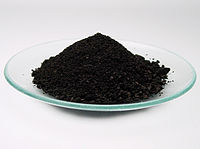
Photo from wikipedia
Different iron carbides were synthesized from the iron oxalate precursor by varying the CO carburization temperature between 320 and 450 °C. These iron carbides were applied to the high-temperature Fischer–Tropsch… Click to show full abstract
Different iron carbides were synthesized from the iron oxalate precursor by varying the CO carburization temperature between 320 and 450 °C. These iron carbides were applied to the high-temperature Fischer–Tropsch synthesis (FTS) without in situ activation treatment directly. The iron oxalate as a precursor was prepared using a solid-state reaction treatment at room temperature. Pure Fe5C2 was formed at a carburization temperature of 320 C, whereas pure Fe3C was formed at 450 °C. Interestingly, at intermediate carburization temperatures (350–375 °C), these two phases coexisted at the same time although in different proportions, and 360 °C was the transition temperature at which the iron carbide phase transformed from the Fe5C2 phase to the Fe3C phase. The results showed that CO conversions and products selectivity were affected by both the iron carbide phases and the surface carbon layer. CO conversion was higher (75–96%) when Fe5C2 was the dominant iron carbide. The selectivity to C5+ products was higher when Fe3C was alone, while the light olefins selectivity was higher when the two components (Fe5C2 and Fe3C phases) co-existed, but the quantity of Fe3C was small.
Journal Title: Catalysts
Year Published: 2019
Link to full text (if available)
Share on Social Media: Sign Up to like & get
recommendations!